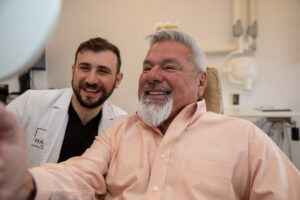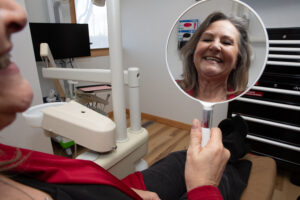Cosmetic braces are orthodontic options designed to straighten teeth while staying low-profile. Many adults and image-conscious teens choose them because they want a better-looking smile without the obvious look of metal brackets. This article explains what cosmetic braces are, the common types, who makes a good candidate, benefits and risks, what the treatment looks like, and practical questions to ask so you can decide if cosmetic braces are right for you.
What Are Cosmetic Braces?
Cosmetic braces are treatments that move teeth into better positions with an emphasis on minimal visibility. They include clear aligners, ceramic (tooth-colored) brackets, and lingual braces placed behind teeth. While the goal is often improved appearance, most cosmetic braces also correct alignment, spacing, and minor bite issues. They aim to balance aesthetics and function.
Common Types of Cosmetic Braces
Clear aligners
Clear aligners are removable plastic trays made from a series of planned positions. You wear them about 20–22 hours a day and switch trays every 1–2 weeks. They are nearly invisible and let you eat and brush normally, which many adults prefer.
Ceramic (clear) braces
Ceramic braces use tooth-colored or clear brackets bonded to the front of teeth. They work similar to metal braces but blend into teeth, making them less noticeable. They can be slightly larger or more fragile than metal brackets and sometimes cost more.
Lingual braces
Lingual braces attach to the back (tongue side) of teeth. They are hidden from view, making them the most discreet bracket option. They may be harder to clean and can affect speech briefly while you adapt.
How Cosmetic Braces Differ From Traditional Braces
Appearance and visibility
Traditional metal braces are more visible because of their metal brackets and wires. Cosmetic options aim to reduce that visibility—aligners are clear, ceramic brackets match tooth color, and lingual braces are hidden behind teeth.
Comfort and hygiene
Removable aligners make eating and cleaning teeth easier compared with fixed appliances. Ceramic and lingual braces can trap food, so brushing and flossing take more effort. Some patients find aligners more comfortable, but every mouth responds differently.
Treatment time and complexity
For mild-to-moderate alignment issues, cosmetic braces can match the timeline of traditional braces. Severe bite problems, jaw discrepancies, or large tooth movements may be faster or more effectively treated with traditional metal braces or combined orthodontic and surgical approaches.
Who Is a Good Candidate for Cosmetic Braces?
Ideal candidates are adults or older teens with mild-to-moderate crowding, gaps, or alignment concerns who want less-visible treatment. People who can keep to a wear schedule (for aligners) and maintain good oral hygiene do best. Patients with severe bite issues, major jaw misalignment, or complex bite correction needs may need traditional orthodontics or additional treatments.
Benefits and Risks of Cosmetic Braces
Key benefits
– Discreet appearance for a confident smile. – Improved oral hygiene for aligner wearers (removable trays). – Predictable outcomes when digital planning is used. – Boosted confidence and a healthier bite when treatment succeeds.
Potential risks and trade-offs
– Aligners need strong patient compliance. – Some cosmetic options can take longer for complex cases. – Teeth can relapse without proper retainers. – Rare side effects include temporary tooth sensitivity or minor root shortening over long treatment times.
Treatment Process: What to Expect with Cosmetic Braces
Initial consultation and exam
Expect a review of your medical/dental history, photos, and either digital scans or impressions. The dentist will discuss your goals, evaluate bite and tooth alignment, and recommend the best cosmetic option.
Digital planning and timelines
Many practices use digital treatment planning to simulate results and map tooth movements. Typical treatment ranges from 6 months for minor shifts to 18+ months for more involved cases. Check-ups usually occur every 4–8 weeks or per your provider’s plan.
Retention and long-term care
After active treatment, retainers are essential to keep teeth in their new positions. Your provider will recommend a retainer schedule and periodic follow-ups to prevent relapse.
Why Choose an Experienced Cosmetic Dentist for Cosmetic Braces?
Experience matters for accurate diagnosis, choosing the right appliance, and handling unexpected issues. An experienced cosmetic dentist can interpret scans, predict movement limits, and integrate restorative needs. HAR Dental Group, led by Dr. Omar Harmouche, DMD (Tufts-trained with implant and restorative expertise), offers comprehensive care and digital planning to help achieve reliable, aesthetic results without overpromising.
Tools That Improve Cosmetic Braces Outcomes
Modern tech helps lower surprises and improve fit. High-resolution intraoral scanners (Primescan) create accurate digital models. Cone Beam CT (CBCT) helps with complex cases that need 3D views. In-house 3D printing (Primeprint) can produce precise aligner models and guides. These tools speed planning, improve comfort, and raise the chance of predictable results.
How to Decide If Cosmetic Braces Are Right for You
Decision checklist: – What are your cosmetic goals? – How complex is your misalignment? – Will you reliably wear aligners if recommended? – What is your budget and insurance coverage? – Does the provider offer a digital preview and a clear retention plan? Ask: expected timeline, who will manage treatment, and how relapse is prevented.
Quick FAQs About Cosmetic Braces
Q: Are they painful? A: Most patients feel pressure, not sharp pain. Discomfort usually fades after a few days with each new stage. Q: How long do they take? A: Many cases finish in 6–12 months; more complex cases take longer. Q: Can adults get them? A: Yes. Adults are often the best candidates for discreet options. Q: Will insurance cover them? A: Coverage varies. Cosmetic-focused treatment may have limited coverage. Check with your insurer. Q: Do I need retainers? A: Yes—retainers are critical to keep results long-term.
Next Steps
If you’re considering cosmetic braces in Tulia, TX, schedule a consultation to review your bite and cosmetic goals. A tech-forward, patient-centered practice like HAR Dental Group with Dr. Omar Harmouche can offer digital planning and a personalized plan. Ask for a digital smile preview, timeline estimate, and retention plan when you book.






